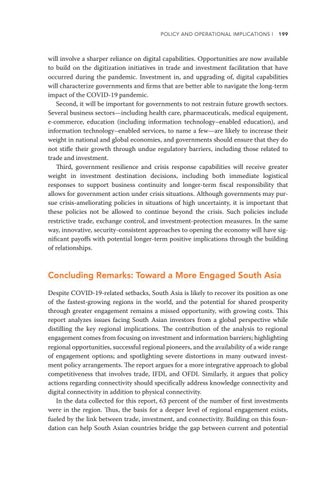POLICY AND OPERATIONAL IMPLICATIONS l 199
will involve a sharper reliance on digital capabilities. Opportunities are now available to build on the digitization initiatives in trade and investment facilitation that have occurred during the pandemic. Investment in, and upgrading of, digital capabilities will characterize governments and firms that are better able to navigate the long-term impact of the COVID-19 pandemic. Second, it will be important for governments to not restrain future growth sectors. Several business sectors—including health care, pharmaceuticals, medical equipment, e-commerce, education (including information technology–enabled education), and information technology–enabled services, to name a few—are likely to increase their weight in national and global economies, and governments should ensure that they do not stifle their growth through undue regulatory barriers, including those related to trade and investment. Third, government resilience and crisis response capabilities will receive greater weight in investment destination decisions, including both immediate logistical responses to support business continuity and longer-term fiscal responsibility that allows for government action under crisis situations. Although governments may pursue crisis-ameliorating policies in situations of high uncertainty, it is important that these policies not be allowed to continue beyond the crisis. Such policies include restrictive trade, exchange control, and investment-protection measures. In the same way, innovative, security-consistent approaches to opening the economy will have significant payoffs with potential longer-term positive implications through the building of relationships.
Concluding Remarks: Toward a More Engaged South Asia Despite COVID-19-related setbacks, South Asia is likely to recover its position as one of the fastest-growing regions in the world, and the potential for shared prosperity through greater engagement remains a missed opportunity, with growing costs. This report analyzes issues facing South Asian investors from a global perspective while distilling the key regional implications. The contribution of the analysis to regional engagement comes from focusing on investment and information barriers; highlighting regional opportunities, successful regional pioneers, and the availability of a wide range of engagement options; and spotlighting severe distortions in many outward investment policy arrangements. The report argues for a more integrative approach to global competitiveness that involves trade, IFDI, and OFDI. Similarly, it argues that policy actions regarding connectivity should specifically address knowledge connectivity and digital connectivity in addition to physical connectivity. In the data collected for this report, 63 percent of the number of first investments were in the region. Thus, the basis for a deeper level of regional engagement exists, fueled by the link between trade, investment, and connectivity. Building on this foundation can help South Asian countries bridge the gap between current and potential

